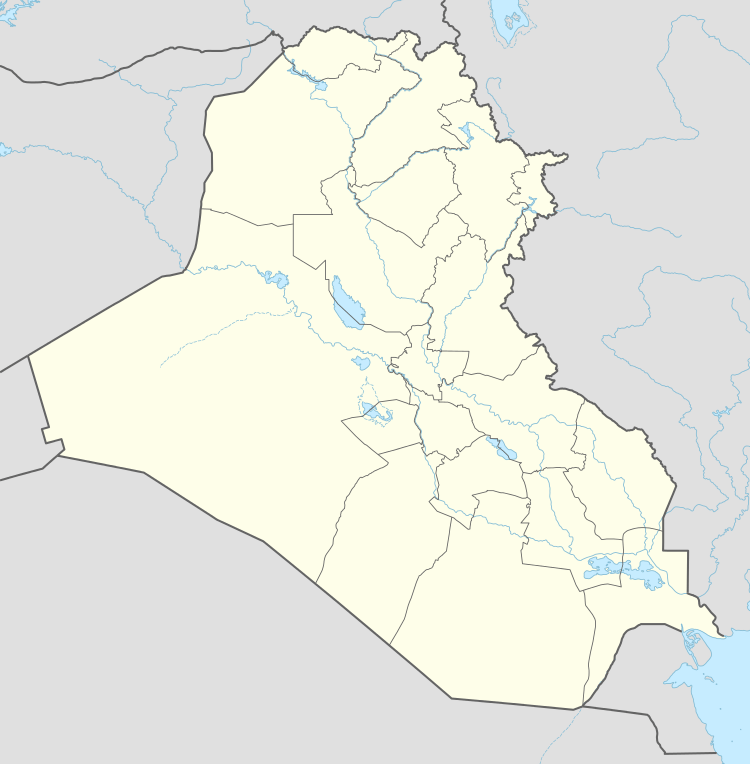Baba Gurgur
| Baba Gurgur | |
|---|---|
 The Eternal Fire at Baba Gurgur | |
 Location of Baba Gurgur | |
| Country |
|
| Coordinates | 35°31′58″N 44°20′09″E / 35.5329°N 44.3357°ECoordinates: 35°31′58″N 44°20′09″E / 35.5329°N 44.3357°E |
| Operator | Iraq Petroleum Company |
| Field history | |
| Discovery | 1927 |
Baba Gurgur (Central Kurdish: بابەگوڕگوڕ) is a large oil field and gas flame near the city of Kirkuk which was the first to be discovered in Northern Iraq in 1927. The field is 40 meters in diameter and has been burning for 2,500 years.
It was considered the largest oil field in the world until the discovery of the Ghawar field in Saudi Arabia in 1948. Baba Gurgur is 16 kilometres north-west of Arrapha and is famous for its Eternal Fire (Arabic: النار الازلية) at the middle of its oil fields.
Name
The name Baba Gurgur derives from Turkmen Baba (father) and Gur (fiery, fire, flowing). The name is translated form Kurdish into "Father of Eternal Fiery".
Eternal Fire
Some believe the Eternal Fire to be the fiery furnace mentioned in the Book of Daniel, chapter 3 in the Tanakh (Old Testament) into which King Nebuchadnezzar (c. 630–562 BC), King of Babylon, threw three Hebrews for refusing to worship his golden idol.[1] It has a significant symbolic value for residents of Kirkuk. Even though the practice is dying out, Kurdish women from all over Kurdistan and Iraq used to visit Baba Gurgur, asking to have a baby boy: "father of fire, I come with fire/hurry, to be a mother to a boy' (Kurdish: "babe gur-gur hatim be gur, bibim be dayikî kur"). This ancient practice probably goes back to the time of fire worshipping or other belief systems which put earthly elements such as fire, the sun, etc. at the center of their practices. The burning flames are the result of an emission of natural gas through cracks in the Baba Gurgur area's rocks. It is believed that the heat of the eternal flames was used by shepherds to warm their flocks during winter.[2]
Oil strike

In 1927, an oil well was spudded at Baba Gurgur by the Turkish Petroleum Company (the forerunner of the Iraq Petroleum Company). At 3 a.m. on October 15, 1927, oil was struck and a great fountain spurted over the crown of the derrick to a height of 42 metres. It soon became clear the company had a major environmental crisis on its hands. The oil well was situated in a depression known as Wadi Naft that carried water off the low foothills, and crude oil was escaping down to the open desert. The spraying oil also threatened the local inhabitants, whose adjacent properties stood in danger of being destroyed, and there was risk of polluting the water supply.
Kirkuk, and the surrounding villages, were in danger of being drowned in a deluge of oil. Being unable to stop the flow immediately, the problem for the Company was how to contain it. Eventually it was decided to commence building dams in the wadi at distances of about 1.5 kilometres apart. A piece of low ground was selected about 24 kilometres away from the well, which could be easily dammed up to hold several weeks of oil production. It was estimated that 2,000 men would be required for the dam's construction. Men from the Kurdish Jubur tribe along the Zab river, and the Arab Obaid tribe on the Hawija plain were soon converging on Kirkuk. A few lucky men rode in vehicles, but most walked, in some cases distances up to 60 kilometres.
A blue mist formed at night in the hollows of the low hills caused by gas pockets. One night the poisonous effects of gas collecting in a depression killed two drillers and three Iraqi workers. The risk of fire was ever-present as for hundreds of metres around everything was smothered in oil. Men were working in gas masks almost naked in an endeavour to get near enough to set up some control appliances. The oil fell evenly in clouds all around the derrick and draw-works due to the windless autumn days. Eventually, the cloud of oil was blown away from one side of the derrick to allow work to start on the well head by using an aero engine.
It took ten days from the first eruption to close the control valve and shut off the supply of oil. Initial flow rate was variously estimated at from 35,000 to 95,000 barrels of oil per day.[3] The approaching rainy season raised the spectre of another disaster: if the rains came and the wadi flooded, the oil would be carried down to the river and pollute water supplies across the whole country. Pumps were urgently installed to pump the oil back into the wells, but they made little impression. Desperate to remove the oil, large quantities were set alight. When the rains came the area was clear of oil. Work on clearing up the area was completed by Christmas Day 1927.[4]
See also
- Iraq Petroleum Company NOC – North Oil Company
- Door to Hell – another perpetual flame in Turkmenistan
- Centralia mine fire
References
- ↑ Yergin, Daniel (January 15, 1991). The Prize: The Epic Quest for Oil, Money, and Power. United States: Simon & Schuster. p. 204. ISBN 0-671-79932-0.
- ↑
- ↑ "Report III of the Federal Oil Conservation Board". January 1928: 149. Retrieved 15 October 2015.
- ↑ Michael Quentin Morton, In the Heart of the Desert: the Story of an Exploration Geologist and the Search for Oil in the Middle East, published by Green Mountain Press, 2006, pp. 8–11, ISBN 0-9552212-0-X.